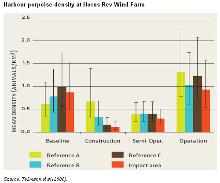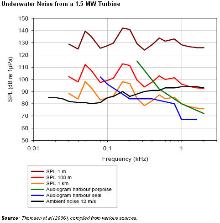Pelagic Ecology Operational Impact
The positive ecological impact associated with the presence of a cumulative surface area of over
100,000m2 of foundation structure has been mentioned in sub-section 5.8. The general benefits to
fisheries are further elaborated in sub-section 8.7.
It is also possible that the wind farm underwater structures will attract fishes and invertebrates to
the area, and that porpoises might make use of such newly-created habitat, as has been found in
situations in northern Europe.
Underwater Noise
Underwater noise data from a 1.5MW turbine operating in winds of 12 m/s collected by ITAP (2005)
was used to predict sound pressure levels at distances of 1 m, 100 m and 1 km from the turbine.
Using the harbour porpoise as a proxy for the finless porpoise (sub-section 6.6.3 refers); noise
may be audible at a distance of 100m from the turbine, but not at a distance of 1 km (ibid.). The
results are broadly similar to observations of response to underwater noise from a simulated 2 MW
turbine, with the distance of approaches by harbour porpoise increased from a median of 120 to
182 m.
At Horns Rev Offshore Wind Farm there was a drop in porpoise distribution during piling, but
recovery to baseline levels during operation. Thus, while it appears that there may potentially be a
behavioural response from finless porpoises to turbine noise, significant adverse impacts are not
anticipated.
As referred previously, we can assume a general hearing range for fish of 30 Hz to 1 kHz (Popper et
al, 2004), although it has also been suggested that fish display a weak response to sounds in the
range 50 Hz to 1 kHz and that in this range the influence of turbine noise is likely to be minor.
Low frequency noise below 50 Hz is considered to be of most importance for fish, and this has
been suggested as the reason why fish display a consistent behavioural response and even an
attraction to low frequency disturbance (Knudsen et al, 1994; Westerberg, 1995). Wahlberg and
Westerberg (2005) estimate the range within which fish may be scared away from a turbine to be
less than 5 metres. Accordingly, significant adverse underwater noise impacts on fish are not
anticipated.
Studies of medium sized offshore support and supply vessels indicate noise is mainly generated
at frequencies between 20 Hz and 10 kHz (Richardson et al. 1995) and thus outside the key
frequencies of concern.
Marine Vessel Collision Risk
The collision risk is negligible considering the low density of marine mammal and sea turtle activity
in Eastern Waters, and when compared with the marine traffic volume of over 2,000 vessel
movements per day through the core habitat of the Indo Pacific hump-backed dolphin Sousa
chinensis on a daily basis.
Electro-magnetic Field
Most marine species can detect electromagnetic fields, although some species are considered to
be potentially more susceptible than others. Concerns regarding effects on prey detection of rays
and sharks, for example, have been raised in the past although current knowledge is limited in
terms of species-specific data. The industry standard 132kV cables to be adopted by the proposed
project have been shown to produce a magnetic field of 1.6T and an induced electric field of
approximately 91V/m. This magnetic field is small in comparison the Earth’s natural
geomagnetic field of 50T, and is estimated to fall to background levels at a distance of ~20m from
the cable corridor .
As two parallel cables are to be installed for the wind farm operation there shall be a cumulative
effect, although the strength of the field is limited when cables are buried as sediment dissipates
the induced electric field much more rapidly than sea water (ibid.). Accordingly, the effects of the
field on fishes and other marine life are anticipated to be negligible.
Artificial Lighting
Existing potential marine threats to sea turtles from marine traffic (6.7.3 refers) and floating debris
will not increase during Project operation as the wind farm area would be under strict management
control.
As regards terrestrial threats associated with project operation, artificial lighting could deter an
adult female Green Turtle from emerging from the sea to nest, although there shall be no lighting
within some 10 km of the nesting beach at Tai Long Wan while well-lit container vessels use the
approach to Yantian Port 24-hours a day. In this context, and given that Green Turtles have been
tracked passing through HKSAR Eastern Waters (e.g., AFCD, 2003) under existing baseline
conditions, artificial lighting from the offshore turbines is not anticipated to result in any adverse
impact on adult female Green Turtles that may come into the area.
For Green Turtle hatchlings, lighting behind a nesting beach may disorient emerging hatchlings
away from the sea as hatchlings tend to move towards the brightest direction (NOAA, 2008). In the
case of the proposed Project, this direction would still be towards the broad horizon of the open
sea, and no adverse impact would arise.
The positive ecological impact associated with the presence of a cumulative surface area of over
100,000m2 of foundation structure has been mentioned in sub-section 5.8. The general benefits to
fisheries are further elaborated in sub-section 8.7.
It is also possible that the wind farm underwater structures will attract fishes and invertebrates to
the area, and that porpoises might make use of such newly-created habitat, as has been found in
situations in northern Europe.
Underwater Noise
Underwater noise data from a 1.5MW turbine operating in winds of 12 m/s collected by ITAP (2005)
was used to predict sound pressure levels at distances of 1 m, 100 m and 1 km from the turbine.
Using the harbour porpoise as a proxy for the finless porpoise (sub-section 6.6.3 refers); noise
may be audible at a distance of 100m from the turbine, but not at a distance of 1 km (ibid.). The
results are broadly similar to observations of response to underwater noise from a simulated 2 MW
turbine, with the distance of approaches by harbour porpoise increased from a median of 120 to
182 m.
At Horns Rev Offshore Wind Farm there was a drop in porpoise distribution during piling, but
recovery to baseline levels during operation. Thus, while it appears that there may potentially be a
behavioural response from finless porpoises to turbine noise, significant adverse impacts are not
anticipated.
As referred previously, we can assume a general hearing range for fish of 30 Hz to 1 kHz (Popper et
al, 2004), although it has also been suggested that fish display a weak response to sounds in the
range 50 Hz to 1 kHz and that in this range the influence of turbine noise is likely to be minor.
Low frequency noise below 50 Hz is considered to be of most importance for fish, and this has
been suggested as the reason why fish display a consistent behavioural response and even an
attraction to low frequency disturbance (Knudsen et al, 1994; Westerberg, 1995). Wahlberg and
Westerberg (2005) estimate the range within which fish may be scared away from a turbine to be
less than 5 metres. Accordingly, significant adverse underwater noise impacts on fish are not
anticipated.
Studies of medium sized offshore support and supply vessels indicate noise is mainly generated
at frequencies between 20 Hz and 10 kHz (Richardson et al. 1995) and thus outside the key
frequencies of concern.
Marine Vessel Collision Risk
The collision risk is negligible considering the low density of marine mammal and sea turtle activity
in Eastern Waters, and when compared with the marine traffic volume of over 2,000 vessel
movements per day through the core habitat of the Indo Pacific hump-backed dolphin Sousa
chinensis on a daily basis.
Electro-magnetic Field
Most marine species can detect electromagnetic fields, although some species are considered to
be potentially more susceptible than others. Concerns regarding effects on prey detection of rays
and sharks, for example, have been raised in the past although current knowledge is limited in
terms of species-specific data. The industry standard 132kV cables to be adopted by the proposed
project have been shown to produce a magnetic field of 1.6T and an induced electric field of
approximately 91V/m. This magnetic field is small in comparison the Earth’s natural
geomagnetic field of 50T, and is estimated to fall to background levels at a distance of ~20m from
the cable corridor .
As two parallel cables are to be installed for the wind farm operation there shall be a cumulative
effect, although the strength of the field is limited when cables are buried as sediment dissipates
the induced electric field much more rapidly than sea water (ibid.). Accordingly, the effects of the
field on fishes and other marine life are anticipated to be negligible.
Artificial Lighting
Existing potential marine threats to sea turtles from marine traffic (6.7.3 refers) and floating debris
will not increase during Project operation as the wind farm area would be under strict management
control.
As regards terrestrial threats associated with project operation, artificial lighting could deter an
adult female Green Turtle from emerging from the sea to nest, although there shall be no lighting
within some 10 km of the nesting beach at Tai Long Wan while well-lit container vessels use the
approach to Yantian Port 24-hours a day. In this context, and given that Green Turtles have been
tracked passing through HKSAR Eastern Waters (e.g., AFCD, 2003) under existing baseline
conditions, artificial lighting from the offshore turbines is not anticipated to result in any adverse
impact on adult female Green Turtles that may come into the area.
For Green Turtle hatchlings, lighting behind a nesting beach may disorient emerging hatchlings
away from the sea as hatchlings tend to move towards the brightest direction (NOAA, 2008). In the
case of the proposed Project, this direction would still be towards the broad horizon of the open
sea, and no adverse impact would arise.

Underwater noise from a wind turbine
(please click to enlarge)
(please click to enlarge)


